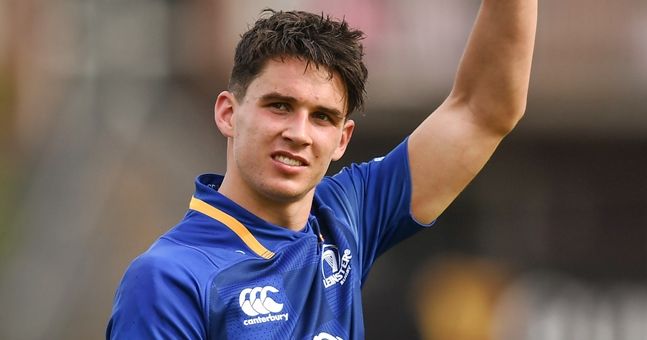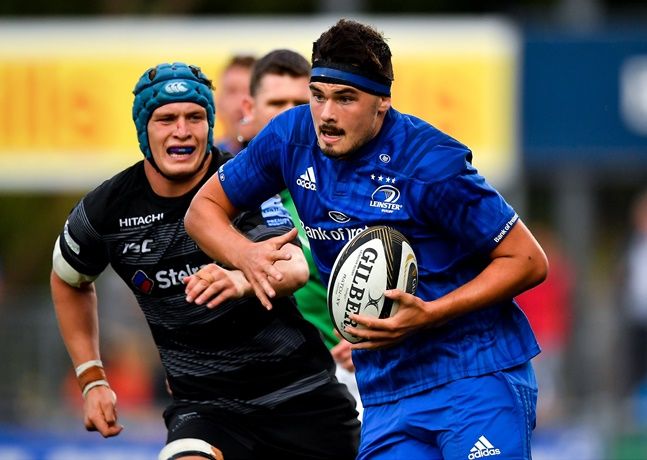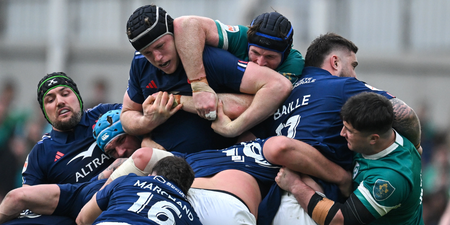Munster fly-half Joey Carbery may be forever viewed as the one that got away for Leinster.
The prodigious 23-year-old signed for Munster last summer after months of being linked with a move north to Ulster and it’s worked out perfectly for the out-half.
He plays outside Conor Murray, he consistently starts in a team at fly-half, as opposed to occasionally being brought in as full-back at Leinster, and he has the backing of a coach in Johann van Graan that wants to attack.
In many respects the move south has worked out perfectly for Carbery. For month after month he publicly dismissed a move away from Leinster ‘as media speculation’ yet behind closed doors there were conversations with numerous stakeholders, including Ireland head coach Joe Schmidt, about his future.
Carbery made the right choice in moving south. When he was at Leinster he was put in the precarious position of being the second-choice fly-half for Ireland yet the third-choice fly-half for Leinster behind Johnny Sexton and Ross Byrne. It was clearly becoming an untenable situation.

Carbery had started just one of his 14 games at 10 for Leinster last season and it became abundantly clear to him, and everyone else watching, that if he wanted to develop in the position he would have to move elsewhere.
Leinster, and particularly Cullen, hitched his wagon to Byrne as the club’s deputy fly-half, and while the young pivot has impressed in the absence of Sexton, Carbery is the top points scorer in the Champions Cup this season.
For basketball fans, Leinster letting Carbery walk to their biggest rivals is reminiscent of the time the Oklahoma City Thunder let future MVP contender James Harden go to the Houston Rockets so that they could essentially keep Serge Ibaka, who they traded three years ago.
Sports teams make mistakes and for Leinster this is undoubtedly a big blunder for the province that unfortunately comes with the territory of their academy.
Irish Times rugby correspondent Gerry Thornley compared Leinster’s academy to famed Dutch football club Ajax in 2017 and it’s a comparison that rings true.
Every time a great players bows out, a new prospect steps right up.
Brian O’Driscoll is soon replaced by Garry Ringrose.
Sean O’Brien has to contend with Dan Leavy and Josh van der Flier.
Rob Kearney will eventually be succeeded by Jordan Larmour at full-back.
Mike Ross bows out and in steps Tadhg Furlong with Andrew Porter behind him.
The depth is absurd and the problem for Leinster is certainly not developing players but rather selecting which men to keep and which players they can point towards the motorway.
Take the following back-row players:
Nick Timoney (23), Conor Oliver (23), Paul Boyle (22), Max Deegan (22), Caelan Doris (20) and Will Connors (22).
Six back-rowers. Six players within three years of each other in age. Six players that have come through the Leinster underage system yet Timoney, Oliver and Boyle have all since moved on to Ulster, Munster and Connacht respectively while Deegan, Doris and Connors have been retained by Leinster.

It will take a few years still before it becomes clear which of those players establish themselves as regular starters for their province and which, if any, progress to become full-time Ireland internationals but essentially it’s a coin flip for Leinster in terms of what players stay and what players go.
In Joe Schmidt’s initial 38-man squad for the 2019 Six Nations, 16 players that were selected were with Leinster while a further six players – Carbery, Tadhg Beirne, Jordi Murphy, Tom Farrell, John Cooney and Andrew Conway – had initially come through the province’s academy or played for the club’s senior team before eventually moving on to new pastures.
Essentially, just over 55% of Ireland’s latest Six Nations squad had stemmed from one province’s academy while the likes of Jack McGrath are also tipped to move on next season in search of increased game time.
It’s the price of greatness. The idea is that the reigning PRO14 and Champions Cup champions pick the best players available to them while letting those deemed surplus to requirements walk, which, given the level of talent involved, can often come back to bite them just as quick.
Leinster’s loss is generally Irish Rugby’s gain when those players stay within the system and we’ve seen just how beneficial interprovincial transfers can be for the likes of Carbery, Cooney and Conway in particular.
Fortunately for Leinster, they are still on course to defend both their PRO14 and Champions Cup crowns so even though they have lost the likes of the aforementioned they’re still more than capable of competing, and with their production line reeling off the likes of James Ryan, Leavy, van der Flier, Furlong, Larmour, Ringrose, Porter and more on a near bi-annual basis, they should be more than equipped to ensure that they are in the reckoning for years to come.
But the Carbery loss will sting, especially given the fact that Johnny Sexton will be just shy of 37 by the time that Carbery’s next contract expires while the Munster fly-half will still only be 26 and what should be the prime of his career.
Johann van Graan’s side have secured a gem in Carbery and one of the moves of the summer could turn into one of the moves of the decade if they can keep in Limerick until 2022 and beyond.

















































